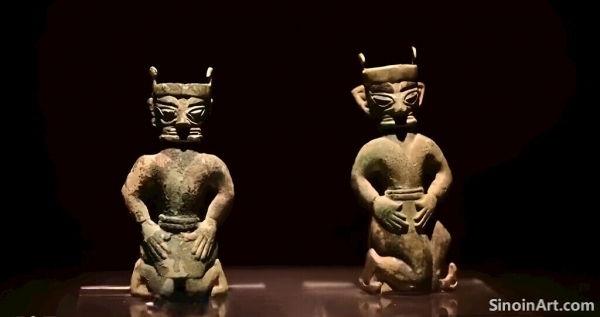The Influence of Nomadic Cultures on Chinese Bronze Ware: Cross-Cultural Exchanges
|
The history of Chinese bronze ware is not just a story of internal development; it is also a story of cultural exchanges and interactions with neighboring nomadic groups. These interactions often resulted in the adoption of new forms, styles, and techniques, enriching the overall artistic landscape of ancient China. The interplay between China and its neighbors created a dynamic and unique artistic culture.  Nomadic groups, such as the Xiongnu and Scythians, often had their own unique traditions of metalworking, which were often incorporated into Chinese designs, especially in border regions. These different cultural influences helped to introduce new forms and styles to Chinese bronze work. The cross-cultural exchange helped to create a unique hybrid art form.  Bronze objects reflecting nomadic influence often include animal motifs, geometric patterns, and stylized depictions of nature. These motifs differ greatly from the traditional designs of the Central Plains regions, and help to show a more diverse vision of the art form. The nomadic influences helped to broaden the range and scope of Chinese artistic expression.  The exchange of bronze objects through trade and diplomacy also played a role in the transmission of artistic ideas and technical skills. The trade routes between different cultural groups helped to spread artistic knowledge and technical skill. The sharing of techniques helped to enrich and broaden the range of metalworking techniques available at the time. The study of nomadic influence on Chinese bronze ware highlights the interconnectedness of ancient cultures and the importance of cross-cultural interaction in artistic and technological innovation. This dynamic interplay of ideas and artistic styles helped to create a more diverse and interesting culture. |
Tag : nomadic influence bronzes, Chinese bronze, Xiongnu culture, Scythian art, cross-cultural exchange
Related information
- The Use of Bronze in Ancient Chinese Transportation Systems: Harnesses, Decorations, and the Technology of Movement
- The Ritual Vessels of the Shang Dynasty: Power and Symbolism in Bronze
- Bronze Ware and the Representation of Power in Ancient Chinese Royal Tombs: Scale, Detail, and Symbolism
- The Taotie Motif: Unraveling the Mystery of the Shang Bronze Beast
- Bronze Ware and Ancient Chinese Astronomy: Celestial Charts and Observational Tools
This article explores the use of bronze in ancient Chinese transportation systems, highlighting its role in creating harnesses, decorative elements, and fittings for chariots and other vehicles, and underscoring its importance for the efficiency of transportation and travel.
This article focuses on the ritual vessels of the Shang Dynasty, exploring their role in ancestral rites, their symbolic designs including the taotie, and highlighting the remarkable craftsmanship of the bronze workers.
This article explores the use of bronze ware in ancient Chinese royal tombs, highlighting its role in conveying power and wealth, its use of scale and detail, its symbolic designs, and how these objects were intended to ensure the continued recognition of the deceased in the afterlife.
This article explores the taotie motif found on Shang Dynasty bronzes, discussing its composite features, the various interpretations of its symbolic meaning, its evolution over time, and its significance in understanding the Shang worldview.
This article explores the use of bronze in ancient Chinese astronomy, focusing on the creation of armillary spheres, sundials, and other observational tools, demonstrating the integration of art, technology, and the ancient quest to understand the cosmos.